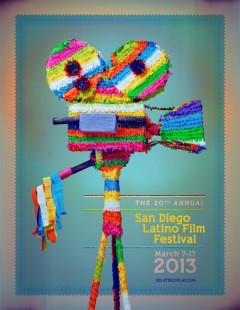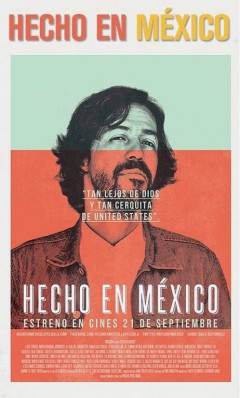San Diego Is (Almost) Famous Again: Cameron Crowe Brings his Movie to the Old Globe Stage by Raul SandelinSeptember 2019
The End of the Line for Mad, the Magazine That Was Satirical, Silly, and Serious by Paul HomiczAugust 2019

The official Latino Film Festival poster

Poster for the movie “Hecho en Mexico”
A sleepy Navy town no more, San Diego has become a leader in a number of high-profile industries. First came the micro beer then coffee and LBGT tourism. Now, America’s finest city is becoming a mecca for film festivals.
But, our reputation for high culture is definitely still young and fragile. I remember back around 1984 when Dan Rather stood in downtown El Cajon (I’m from El Cajon) and proclaimed our fair city the crystal meth capital of the U.S. Like a new, first-time papa, I gushed with pride. At the time, it was an honor just to be the capital of anything, even the capital of toothless bikers and 72-hour-long garage-band jam sessions.
Fast forward 30 years and San Diego (and even El Cajon) has jumped ahead of the curve on a lot of things. Grossmont College professor William Snead, a pillar in the local film community, estimates that there are now 24 different film festivals held annually in San Diego County. There is a Black Film Festival, an Asian Film Festival, a Jewish, gay, and several student film festivals. Spike and Mike’s Festival of Animation and Susy Botello’s Mobil Film Festival, which is dedicated to shorts filmed exclusively on cell phones, appeal to specialty niches. And, let’s not forget Comic Con, which isn’t a film festival per se although it sure acts like one.
This month, it’s the Latino Film Festival’s turn to shine. Like the Asian Film Festival, the Latino Film Festival has become an international powerhouse, attracting films and film-industry pros from all continents. This is also the year that the Latino Film Festival turns 20.
Founded by Ethan van Thillo in 1993, the Latino Film Festival started as a venue for mostly local student films from the greater San Diego/Tijuana region. Today, it is attended by some 20,000 people.
The festival, which starts on March 7, lasts for 11 days. During that time, some 160 films from over 20 countries will be screened at two theaters. Most of the films will be shown in constant rotation on four screens at the Digiplex Mission Valley Cinemas at Hazard Center. In addition, there will be a “digital gym” in North Park where classes and screenings will be held. This North Park digital gym also serves as a year-long location for youth filmmaking camps and classes. “It’s a year round program that we maintain thanks in part to the proceeds from the Latino Film Festival,” says van Thillo.
The festival will screen films from every genre including drama, comedy, family, and music documentaries. Three extremely important films this year are Hecho en Mexico, Colosio, and Filly Brown. The latter stars Edward James Olmos.
Hecho en Mexico is a documentary that journeys into the many corners of that country’s music scene. It examines both the old and the new from traditional folklorico to contemporary Mexican pop, rock, and rap. Colosio: El Asesinato is a political detective thriller that revisits the 1994 murder of Mexican presidential candidate Luis Donaldo Colosio. Filly Brown, which in addition to Olmos stars Lou Diamond Phillips, explores contemporary Latino culture north of the border, the story of a young LA poetess and rapper who struggles to break into the music business.
The 160 films cover the full gamut of Latino culture, from the age-old themes of political violence, exploitation, and poverty to the modern themes of globalization and bi-cultural, bi-lingual hybridization.
So, is it any surprise that San Diego is emerging as major force in the film industry? It shouldn’t. After all, San Diego was one of the first cities to establish a film industry dating back to La Mesa’s Flying “A” Studios, under the leadership of famed director Allan Dwan, where nearly 200 cowboy single reels were shot over 100 years ago at a time when Hollywood was still a loose assemblage of horse farms. In fact, San Diego would be the site of many film-industry firsts, a history best examined in the book Filming San Diego: Hollywood’s Backlot by Gregory L. Williams. This book, a must for both San Diego history buffs and film aficionados, traces a 115-year history that started when Thomas Edison’s cameras came to town in 1898. Following Edison and Flying “A” Studios, San Diego would host Mary Pickford and Douglas Fairbanks as they transformed Balboa Park into a variety of exotic settings. A young Frank Capra would film one of the first talkies, Flight, at the Arthur Embleton property in El Cajon. Orson Wells would use the ornate facades of Balboa Park in Citizen Kane. And, let’s not forget about Some Like It Hot, Top Gun, Almost Famous, and, of course, Attack of the Killer Tomatoes.
So, no, it’s no surprise that San Diego, long LA’s red-headed cockroach to the South, should now emerge from the shadows to shine in its own right.
For more information on the Latino Film Festival, please visit the following websites:
www.sdlatinofilm.com and www.digitalgym.org.

